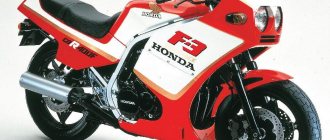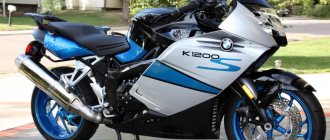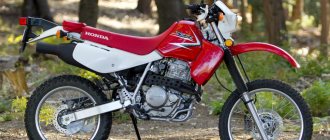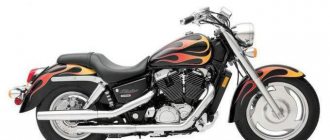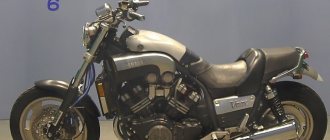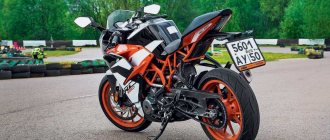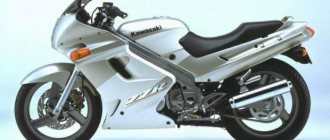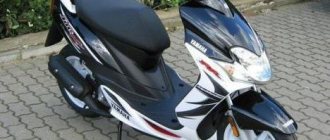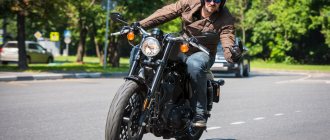000_moto_0211_056
Honda CBR250R: Roadster, 2011, 249.4 cc, 26.2 hp, 165 kg.
Honda CBR250R: Roadster, 2011, 249.4 cc, 26.2 hp, 165 kg.
At the same time, the “chekushka” supplemented the “bottom” range of Honda roadsters - the company’s second Main Breadbasket in the old-world markets, and - most importantly - headed the extensive family of “utilities” in the Asian markets.
Just don’t mock the letters R in the name, deciphering them in a new way! Indeed, this combination of power and weight is more consistent with the good old Jawa 350 or a large-wheeled utilitarian scooter; for example, Honda's SH300. But the SH300 in Europe is offered for 4,500 euros, and the new CBR250R will cost half a thousand less than the “luxury string bag” - and this is already the territory of more modest devices. Let's say the Aprilia Sportcity 300, which weighs almost the same but has 22.4 horsepower.
And the approach to design here is similar to Sportcity: behind the cladding a la sport is a simple, but without primitive, “filling”. Moreover, unlike some competitors, it is entirely and completely modern in design. The frame is open tubular, but its shape hints that the development was carried out in an era when strength and rigidity can be calculated, and not estimated by eye. The suspensions are the simplest, but the Japanese considered it inappropriate to abandon the “progressive” rear (previously they easily did this for liter roadsters, but here they decided that comfort was more important). And the brakes may not be the most “advanced,” but they do have ABS, albeit optional.
The engine was developed in a similar vein. With a wet (and not dry, like enduro engines, and not semi-dry, like the CRF or the same SH300) crankcase, four-valve and two-shaft. But - with roller pushers to reduce losses, and the twisting of the channels, although purely “civilian”, still implies a certain potential for forcing. This is also indicated by the throttle diameter: 38 mm (for the 27-horsepower and 280 cc SH300 - 34). And the low end is well supported by a long, tapered intake pipe, most of which extends deep into the airbox. One more point: the main crankshaft supports are on liners, and the toe support, located in the cover, as well as the balancer shaft and pump supports, are on ball bearings. I see this scheme as optimal in terms of “survivability-repairability” ratio.
The latter is also useful in affluent Europe, the USA and Japan, where a motorcycle is intended to become both an alternative to a scooter - which means it can often be started “cold” - and a simulator for beginners, regularly changing their not very competent and thrifty owners. And this is especially true in the main Asian markets, where the CBR250R will be “premium” by local standards, but still a workhorse, mercilessly driven by its not the most technically competent owners. And all these above-mentioned comrades will appreciate... no, not the style, but the ego-flattering external resemblance to “full-size” Honda motorcycles. And the design is not extravagant (no need to scare the average person!), but modern in every detail, from the wheels to the dashboard. Not a single hello from the time when the most decrepit of the current second-hand stores were the new items of the season.
And that there will be one version, without any “nudity” or “intersection” there, is both logical (it looks richer and hides the cheap “filling”) and technologically. And the chosen production location (like that of the Main Competitor - Thailand plus assembly for local markets in India and, possibly, Brazil) is both budgetary and logistical.
Review of the Honda CBR250R motorcycle
Ergonomics - the fit seemed a little sportier than that of the Ninzi (apparently the clip-ons are further or lower, in any case the body is tilted more strongly). The tidy is an order of magnitude better - almost all the information is on the LCD display, namely: electronic speedometer, clock, temperature, fuel level, coolant temperature, mileage (daily, daily, switchable with a button). There is only one “alarm clock” - the tachometer, so it is large and easy to read. I also liked the pleasant blue lighting. There is a passing button (blink distant).
Dynamics. This is where I liked the Ninya more - the engine is more interesting, you can feel the power increasing right up to the red zone, while you can hardly feel any vibrations right up to the cutoff. There is no point in turning the Siber - it drives almost equally well at 5k and at 8k rpm, while at 9-10k rpm the vibrations are felt slightly. I didn’t want to push into the cut-off point, it was so uncomfortable. Judging by the tachometer, it is somewhere around 12 thousand. As compensation, for quiet city driving the Siberian engine is more convenient, you can switch less often. The brakes on my particular copy were not impressive - the handle sank further than I would like. I also noticed a very uneven stroke of the lever (perhaps something needs to be lubricated there, I don’t know :)). After the ZX-6R on the small Ninza, the brakes also didn’t make me happy, but I would give preference to them among the cheap ones.
Chassis (?).
I haven’t been on Ninza since October, maybe my memory is failing me here. It seemed to me that 1) the Ninja is more nimble, and the Siber is closer to “adult” motorcycles in terms of stability/steering. Perhaps it's the fork offset (Ninja 82mm, Honda 95mm). 2) Siber is heavier. maybe it’s a matter of the center of gravity, or maybe I’ve gotten out of the habit of riding a minimoto and a scooter. 3) the fork of the Sibera is as soft as that of the Ninzi, or even softer.
The motorcycle engine is quite calm, maybe even too quiet. But fuel consumption is incredibly low, about 3 liters per 100 km, maybe a little more. At the same time, the maximum speed of the motorcycle is around 150 km/h, and a comfortable cruising speed does not exceed 100 km/h. But the motorcycle is equipped with disc brakes with an anti-lock system, so the bike is undoubtedly tailored for a beginner, ensuring the safety and flexibility of the motorcycle. In addition, the size of the CBR250R tires allows the bike to be fitted with tires designed for its older sports “brothers”, that is, you can install sports-touring tires with more traction and better grip.
The fuel tank holds only 13 liters of fuel, which means you can cover more than 300 km on one fill-up, which is quite a lot, since not even all touring bikes are capable of covering such distances without refueling, although I don’t think anyone is going on a long trip on the CBR250R.
My son and I bought 250 rubles. I drove 4000 and 6000 km. We’re very happy with the bike, it’s light, economical/I can get about 30 km on 1 liter/it’s quiet, it’s comfortable to sit/I have 110 kg, my son has 130, my stomach doesn’t bother me/. I drove in the rain through puddles, 145 km/h doesn’t skid, abs/two performed very well saved me from an accident on a turn during emergency braking. Now about the downsides. The tires are not very good/the middle is already straight/I will soon change to Pirelli ones. For my son and me, the weight is weak, the front shock absorbers are weak/the springs need to be changed/. It sits low, the fang has already broken on curbs. Unstable on the step,/falls, broke 2 clutch handles and broke the left mirror, bent the gear shift pedal/.
Now a comparison. In Israel, before buying a motorcycle, you can ride on it. I have an A1 license up to 33 hp. The choice is / Hugh-sangGP250, Aprilia 125, Kawasaki Ninja 250, Honda sbr 250/. Hugh dropped out due to a weak gearbox and cooling systems / we have mountains and the heat is 30+ /. Aprilia 125rs / two-stroke, and it is more suitable for children, no longer needed. Kawasaki / less than 6000 rpm it does not start, consumption is 7 liters per 100/2 carburetors in 2011!, warranty 1 20,000 km per year, service every 3,000 km, in the city you drive like a cow/hard to operate and physically/gear shift lever is small, your foot won’t fit under the bottom, you shift with your heel/Due to the heat, constant overheating, the result is a resource of only 60,000 km..Honda/warranty 2 years without mileage limitation / low seating (I really liked it), light, nimble, consumption 3 liters per 100 km, the engine pulls at 4000 rpm - julish between cars in traffic jams, but Honda recommends at least 6000 rpm for 6 lanes / otherwise the cylinder will wear out in waves / keep from 5000 to 7000 rpm. in 6th gear 6000 rpm 100 km/h. I bought a Honda / it’s the most expensive $ 12,000 / I don’t regret it, it’s worth the money! I forgot, service every 12,000 km
Every day I go to work 70 km a day at least Not a single overheat!. At 1000 I did the next service at 12000, but today I changed it again at 4000 km / it got dark and the gears began to click loudly / I filled Repsol 4t 10/40 synthetic, a completely different engine class works! And as for the chain, I apply it with a spray / Forch s405 / Heavy Duty Teflon Chain grease / nothing makes noise. On the highway you drive aggressively 6-8000 rpm, you need to quickly overtake - two clicks down the gas to the limiter 135 km/h, 5th gear 145-150 km/h, at 6 it reached 165 km/h. On long climbs, the engine still grabs / 8000rpm as if it’s hitting a wall, you lower the gear, turn the 9000-limiter - everything is fine. Honda doesn’t see the problem and even recommends sometimes bringing it to the limiter / the computer learns /. The speedometer is lying 8 km/h more, the level sensor Fuel is very approximate/I fill up based on mileage.
006_moto_0211_056
The only key market where the CBR250 is not yet introduced is South America.
For him, the Brazilian branch of Honda has been producing the CB300R roadster since the summer of 2009. Its 26.5-horsepower engine is largely similar to the CBR250 unit, but differs in air-oil cooling and increased displacement. And the chassis is much simpler: with a half-duplex frame, a rear drum brake and no “progression” in the rear suspension - but also with optional ABS. The only key market where the CBR250 is not yet introduced is South America. For him, the Brazilian branch of Honda has been producing the CB300R roadster since the summer of 2009. Its 26.5-horsepower engine is largely similar to the CBR250 unit, but differs in air-oil cooling and increased displacement. And the chassis is much simpler: with a half-duplex frame, a rear drum brake and no “progression” in the rear suspension - but also with optional ABS.
Technical characteristics of Honda CBR250R (manufacturer data)
| COMMON DATA | |
| Model year | 2011 |
| Curb weight, kg | 165 |
| Length × width × height, mm | 2030×709,5×1127 |
| Wheelbase, mm | 1369 |
| Ground clearance, mm | 148 |
| Seat height, mm | 784 |
| Reach, mm | 95 |
| Steering column tilt angle, degrees. | 25 |
| Gas tank volume, l | 13 |
| ENGINE | |
| Type | 1-cyl., 4T |
| timing belt | DOHC, 4 valves per cylinder |
| Working volume, cm³ | 249,4 |
| Dimension, mm | 76×55 |
| Compression ratio | 10,7:1 |
| Supply system | fuel injection, 38 mm |
| Cooling system | liquid |
| Starting system | electric starter |
| Max. power, hp at rpm | 36,2/8500 |
| Max. torque, Nm at rpm | 22,9/7000 |
| TRANSMISSION | |
| Clutch | multi-disc, oil bath |
| Transmission | 6-speed |
| main gear | chain |
| CHASSIS | |
| Frame | open, steel |
| Front suspension | telescopic fork, non-adjustable |
| Pipe diameter, mm | 37 |
| Wheel travel, mm | 130 |
| Rear suspension | pendulum, with monoshock absorber and progressive characteristics, preload adjustment |
| Wheel travel, mm | 104 |
| Brake system | hydraulic, combined, with ABS |
| Front brake | disc Ø 296 mm, 3-piston caliper |
| Rear brake | disc Ø 220 mm, 1-piston caliper |
| Wheels | cast, 5-spoke |
| Front tire | 110/70–17 |
| Rear tire | 140/70–17 |
Untersportbike: Honda CBR250R
Technical characteristics of Honda CBR 250
- category - sport bike.
- years of production - 1986-1996, 2011 - updated model Honda CBR 250 R.
- engine - 4-cylinder, 4-stroke (2011 model - 1 cylinder)
- engine capacity - 250 cubic meters. cm.
- maximum power - 45 hp. With. (29-33 kW).
- 6-speed gearbox.
- fuel system - Keihin 29 mm carburetor.
- starting system - electric starter.
- cooling - liquid.
- Gas tank capacity: 14 liters (3.7 gallons)
- dry weight - 158 kg.
- wheelbase - 1345 mm.
- seat height - 735 mm.
- maximum speed - 185 km/h (115 mph)
Honda CBR250RR
Brief review of Honda CBR250RR
The small-capacity sports motorcycle Honda CBR250RR was produced from 1986 to 1996, but it was sold in showrooms for several years after the end of production, so sometimes you can see, for example, 1997 or 1999 in the PTS of used motorcycles imported into Russia - such inaccuracies sometimes come across. Officially, the CBR250RR was only sold in Japan and Australia. This model should not be confused with the Honda CBR250R, a budget 1-cylinder sportbike produced from 2011 to 2014.
Despite the modest engine displacement, the Honda CBR 250RR is a real full-fledged sportbike, albeit a small one. Nowadays, motorcycles with forced 4-cylinder engines of small volume are no longer produced, giving way to less forced 1-cylinder and 2-cylinder models, since they have a much longer service life.
The Honda CBR 250RR was built on the basis of the 400 cc version of the sports bike - the Honda CBR 400RR, or rather, the engine was borrowed from it, the displacement of which was reduced. The motorcycle has impressive characteristics, but due to the short lifespan and considerable age of all copies, it is quite difficult to find a CBR250RR in good technical condition these days.
Similar motorcycles:
- Yamaha FZR 250
- Suzuki GSX-R 250
- Kawasaki ZXR 250
Specifications Honda CBR250RR
- Years of production: 1986-1996
- Class: sportbike
- Frame: diagonal alloy
- Engine: 4-stroke, 4-cylinder, in-line
- Engine capacity, cubic meters see: 249
- Cooling: liquid
- Valves per cylinder: 4
- Fuel supply: 4 carburetors
- Power: 45 hp at 15,000 rpm (40 hp since 1993)
- Torque: 23.5 Nm at 11500 rpm
- Maximum speed, km/h: 185
- Acceleration from 0 to 100 km/h: 5 seconds
- Transmission: 6-speed
- Wheel drive: chain
- Front tire: 110/70-17
- Rear tire: 140/60-17
- Front brakes: 2 275 mm discs, 2-piston calipers (1 disc on 1988 models)
- Rear brakes: 1 disc 220 mm, 1-piston caliper
- Front suspension: telescopic fork
- Rear suspension: Progressive monoshock with preload adjustment
- Gas tank volume, liters: 13
- Fuel consumption at 110 km/h, liters: ~5
- Dry weight, kg: 143
Pros and benefits of the Honda CBR250RR
- Very high power for 250cc. see working volume
- Good dynamics
- Good brakes (except 1988 model)
- Low price on the secondary market
- Good wind protection at high speeds
Pros and cons of the Honda CBR250RR
- Low service life of the engine and other components
- Fairly high fuel consumption
- Difficulty finding spare parts
- Lack of traction in the lower and middle speed range; for dynamic driving, the engine must be “twisted”
